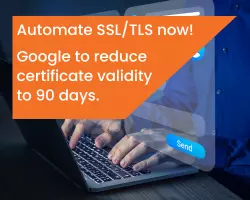Application Programming Interfaces (APIs) are a crucial aspect of modern software applications, linking the various services in a secure environment. Securing the information and data between each service is achieved with a range of methods, such as digital certificates, authentication, and encryption, creating a formidable defense to protect users and organizations.
This article will focus on how digital certificates are used in API integrations to secure interactions within an application, considering how mutual TLS certificates authenticate both the client and server, prevent unauthorized access, and ensure data integrity.
APIs and Application Security
APIs act as facilitators to power software applications, allowing them to communicate with other applications and services. Thanks to APIs, it becomes possible for organizations to integrate third-party services and platforms to build modular, multi-purpose, solutions for staff and customers.
However, integrating external services brings an element of risk that must be mitigated. Such risks include unauthorized access to sensitive information and critical data (e.g. financial details or login credentials) or an API acting as an entry for a cyber-attacker to exploit a vulnerability and install malware. The more services connected to an API, the larger the attack surface of an organization becomes.
The prevalence of microservice architecture in modern software development exacerbates this issue further, creating complex networks that require continuous monitoring, auditing, and management. Therefore, to effectively protect APIs, applications, and connected services, a comprehensive and robust security strategy is required, including implementing a secure PKI-based framework and the use of digital certificates.
An Introduction to Digital Certificates in API Integrations
API security can take many forms, with organizations deploying many tools and techniques to protect their digital architecture. But, in almost all cases, an API security strategy will incorporate digital certificates and encryption techniques that ensure data confidentiality and integrity.
Mutual TLS (Transport Layer Security) certificates, like Mutual SSL X.509 are the most effective and widely used digital certificates for APIs. TLS is a commonly used internet encryption protocol authenticating the server in a client-server connection and encrypting communications.
The implementation of TLS certificates is still considered to be a best practice even as APIs become more advanced, and their architectural sprawl becomes difficult to manage. This includes securing RESTful APIs that use HTTP requests to retrieve, access, modify, and process data.
How Standard TLS Works
Standard TLS protocol can be broken down into three key components:
- Public Key and Private Key Cryptography: TLS uses public key cryptography, which is the method of using a pair of digital keys, a public and private key, to encrypt and decrypt data. When a data transfer is encrypted using the public key, the server must possess a unique private key, generated by an algorithm to decrypt it.
- TLS Certificate: TLS certificates are data files that contain vital information needed to verify the identity of a server or device. Information includes the public key, the issuing certificate authority, and the certificate’s expiration date.
- TLS Handshake: The ‘TLS handshake’ is the authentication process verifying that the server possesses the private key and checks that the TLS certificate is valid. Once authenticated, the TLS handshake then determines how communications will be encrypted.
How Mutual TLS (mTLS) Works
Mutual TLS (mTLS) differs from standard TLS protocol because both the client and the server possess a digital certificate, instead of just the server. This means that both sides must authenticate each other, providing an extra layer of protection.
APIs are often used in eCommerce environments, connecting many third-party services to a platform to provide extended functionality and a wider product offering. Digital certificates are required to secure these endpoints, with mutual TLS requiring both the client and server to verify each time. A common example would be managing product information within eCommerce sites, with the administrator needing to screen and approve content editors before allowing them to access and modify the full catalog - this can easily be achieved with mTLS certificates.
The Benefits of Mutual TLS Certificates in API Integrations
The purpose of mTLS certificates is to ensure traffic between the client and server is fully secured in both directions, preventing sensitive information from falling into the wrong hands. Furthermore, mTLS can verify a connection from a client device without the user logging in, such as when protecting IoT devices that often require a constant connection.
This additional layer of protection can help guard against a wide range of attacks commonly directed at APIs. These attacks may include:
- Malicious API requests: mTLS verifies that all API requests come from a legitimate, authenticated source, preventing malicious threat actors from sending requests that aim to exploit vulnerabilities within the software or modify an API function
- On-path attacks: An on-path attack involves a threat actor positioning themselves between the client and server to intercept or alter communications. mTLS makes this virtually impossible as an attacker cannot authenticate with either the client or server
- Credential stuffing: Threat actors may obtain login credentials via a leak or by stealing them using a technique such as phishing. But, even with these valid credentials, the attacker will still not be authorized without a TLS certificate and private key
- Spoofing: Spoofing involves a threat actor disguising a web URL to make it appear as a legitimate source in the hope users interact with it. This attack becomes much more difficult to execute when both the client and server need to authenticate a digital certificate
- Brute force attacks: Brute force attacks are carried out using automated bots to crack passwords, rapidly using trial and error to narrow down the possibilities in a short space of time. Thanks to digital certificates, an attacker can achieve little by only obtaining a username and password
Although mTLS is a powerful tool in preventing cyber-attacks on APIs they are only a piece of the jigsaw. A truly effective API security strategy needs to consider factors such as the way data is extracted and how it is stored, as a digital certificate can only do so much if other API bases like input validation and continuous monitoring aren’t implemented.
How To Implement Digital Certificates in API Environments
When implementing digital certificates, the first step is to generate a Certificate Signing Request (CSR). Once generated, the digital certificates and keys must be stored securely using a secure vault or a key management service (KMS). As best practices, keys and certificates should never be stored in plain text, hard-coded, or exposed in the code repository, configuration files, or anywhere else in the API environment.
Certificates and keys should always be distributed using a secure channel and a standard format (HTTPS, SFTP, or PKCS#12) while a Certificate Revocation List (CRL) or an Online Certificate Status Protocol (OCSP) can notify clients whenever a certificate has expired or been revoked. An up to date scheduling system can also notify administrators to update certificates before they expire or no longer meet current standards or regulations.
Monitoring API digital certificates is essential to detect and mitigate any vulnerabilities within applications and third-party services. All certificates can be examined using server testing and network scanning tools like SSL Labs or Nmap that can identify vulnerabilities, errors, and misconfigurations. Logging and analytical tools such as Prometheus or Grafana are also recommended to document expiration dates, usage metrics, or errors.
Conclusion
Digital certificates, specifically mutual TLS certificates are used in API environments to authenticate both the client and server, prevent unauthorized access, protect data, and guard against cyberattacks. They form a key part of an API security strategy but cannot be used in isolation. Instead, they must work alongside methods such as input validation, rate limiting, and encryption to secure all connected applications, third-party services, and external platforms.
Note: This blog article was written by a guest contributor for the purpose of offering a wider variety of content for our readers. The opinions expressed in this guest author article are solely those of the contributor and do not necessarily reflect those of GlobalSign.







